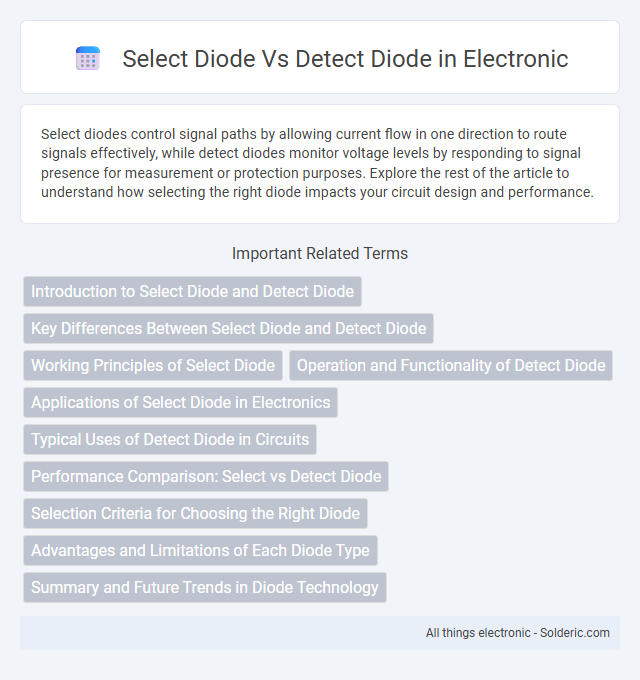Select diodes control signal paths by allowing current flow in one direction to route signals effectively, while detect diodes monitor voltage levels by responding to signal presence for measurement or protection purposes. Explore the rest of the article to understand how selecting the right diode impacts your circuit design and performance.
Comparison Table
| Feature | Select Diode | Detect Diode |
|---|---|---|
| Primary Function | Switches signals in multiplexers | Converts RF/AC signals into DC (rectification) |
| Application | Multiplexing in memory and signal selection | RF detection, wireless receivers, and power measurement |
| Operating Mode | Acts as an electronic switch | Acts as a rectifier and detector |
| Forward Voltage Drop | Low to enable quick switching | Typically low for accurate detection |
| Signal Handling | Handles digital pulses/signals | Handles analog high-frequency signals |
| Key Parameters | Reverse leakage current, switching speed | Responsivity, sensitivity, rectification efficiency |
Introduction to Select Diode and Detect Diode
Select diodes are semiconductor devices used primarily in electronic circuits to control signal routing by allowing current flow in one direction during the selection process, often found in multiplexers and display panels. Detect diodes function by converting alternating current (AC) signals into direct current (DC) for demodulation or signal detection applications, commonly used in radio receivers and sensor circuits. Both diodes optimize circuit performance through their unique electrical characteristics tailored to selection and detection roles.
Key Differences Between Select Diode and Detect Diode
Select diodes are designed primarily for switching and signal routing in circuits, offering fast response times and low forward voltage drops, while detect diodes are optimized for signal detection and rectification with higher sensitivity to weak signals. The select diode functions within multiplexers and digital circuits to control active signal paths, whereas the detect diode is commonly used in RF detectors and demodulation processes to convert AC signals to DC. Understanding these key differences helps optimize Your circuit design by matching the diode type to the specific functional requirements of selection versus detection.
Working Principles of Select Diode
Select diodes function primarily as switches in electronic circuits, allowing current flow only when forward biased, effectively isolating signals to prevent crosstalk and interference. These diodes operate under the principle of selective conduction, where they permit current flow in one direction while blocking it in the reverse, facilitating precise signal routing. Your use of select diodes ensures accurate channel selection and improves overall circuit performance by maintaining signal integrity.
Operation and Functionality of Detect Diode
Detect diodes operate by converting high-frequency signals into measurable DC voltages, enabling precise signal strength detection within RF circuits. Unlike select diodes that switch or route signals, detect diodes function primarily as rectifiers, facilitating accurate measurement of signal amplitudes for monitoring and control applications. Their sensitivity and linearity make them essential for feedback loops in communication systems and radar receivers.
Applications of Select Diode in Electronics
Select diodes are primarily used in multiplexing circuits and signal routing applications within electronic devices, enabling the selection of specific signal paths without interference. Their fast switching capabilities and low forward voltage drop make them ideal for analog signal selection and digital logic circuits. Unlike detect diodes, which are designed for signal demodulation and detection, select diodes optimize circuit efficiency by controlling signal flow in complex electronic systems.
Typical Uses of Detect Diode in Circuits
Detect diodes are commonly used in RF power measurement circuits, envelope detectors, and signal demodulation applications due to their fast response and low forward voltage drop. Their role in circuits includes sensing signal presence, converting AC signals to DC for measurement, and enabling automatic gain control by monitoring signal strength. Unlike select diodes, detect diodes excel in precision detection tasks in communication and measurement equipment.
Performance Comparison: Select vs Detect Diode
Select diodes exhibit faster switching speeds and lower forward voltage drops compared to detect diodes, enhancing circuit efficiency and signal clarity. Detect diodes prioritize sensitivity and accuracy in weak signal detection, often sacrificing speed for improved signal integrity. Your choice between select and detect diodes should balance the need for rapid response and precise measurement based on application demands.
Selection Criteria for Choosing the Right Diode
Selection criteria for choosing the right diode between select diode and detect diode primarily depend on application requirements such as switching speed, forward voltage drop, and frequency response. Select diodes are often optimized for fast switching and low capacitance, making them ideal for signal selection in high-speed circuits. Detect diodes emphasize sensitivity and low leakage current, which are critical for accurate signal detection and demodulation in RF and communication systems.
Advantages and Limitations of Each Diode Type
Select diodes offer precise switching capabilities with low leakage current, making them ideal for multiplexing and signal routing in high-frequency circuits, but they often suffer from slower response times and higher capacitance compared to detect diodes. Detect diodes excel at fast signal detection and rectification due to their low forward voltage and minimal junction capacitance, enabling accurate signal measurement in RF and communication systems, though they typically have higher leakage currents and limited power handling capacity. Your choice depends on whether you prioritize switching precision and isolation (select diodes) or rapid detection and sensitivity (detect diodes) for your specific application.
Summary and Future Trends in Diode Technology
Select diodes prioritize switching speed and precise signal gating, essential in communication systems, while detect diodes focus on high sensitivity and low noise for accurate signal detection in sensors. Advances in semiconductor materials like GaN and SiC promise enhanced performance and energy efficiency for both diode types, enabling faster operation and improved thermal stability. Your adoption of these evolving diodes will benefit from integration with nanotechnology and AI-driven diagnostics, driving future innovations in electronic device functionality.
Select diode vs Detect diode Infographic

 solderic.com
solderic.com